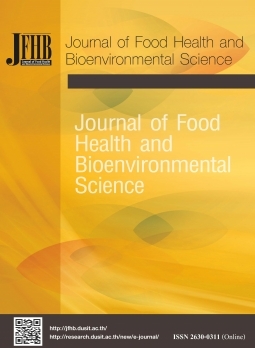Total Phenolics, Flavonoids, DPPH Radical Scavenging and Tyrosinase Inhibition Activities of Sacha inchi (Plukenetia volubilis L.)
Keywords:
Sacha inchi, Phenolics, Flavonoids, DPPH radical scavenging, Tyrosinase inhibitionAbstract
Sacha inchi (Plukenetia volubilis L.) or Inca star is a medicinal plant whose fruits and seeds are mainly used in processing. The objectives of this research were to analyze the total phenolic and flavonoid contents of Sacha inchi from leaves, vines and shells and to study the efficiency of DPPH radical scavenging activities and tyrosinase inhibition activities of Sacha inchi. The leaves, vines and shells were extracted with 95% ethanol using the maceration technique. The crude extracts of leaves, vines and shells were analyzed in terms of total phenolic contents using the Folin-Ciocalteu method, whereas the total flavonoid contents were analyzed using aluminium chloride colorimetric method. The results of the percentage yield in leaves, vines and shells were found to be 19.4815 ±0.0617, 4.81 ± 0.0482 and 2.51 ± 0.0943, respectively. The total phenolic contents in leaves, vines, and shells were 26.3441±0.8895, 37.0925±0.8898 and 30.5202±1.9938 mg of gallic acid/g sample, respectively. The total flavonoid contents were 407.6190±2.5036, 171.2516±3.6696, and 179.0318±3.7771 mg of rutin/g sample, respectively. DPPH radical scavenging activities in leaves, vines and shells were shown with EC50 as 0.0092±0.0090, 0.0803±0.0063 and 0.2527±0.1105 mg/mL, respectively, compared to standard BHT with EC50 as 0.1296±0.0528 mg/ml. The tyrosinase inhibition activities in leaves, vines and shells were shown with IC 50 as 0.0016±0.0107, 0.4924±0.1500 and 0.5986±0.2751 mg/mL, respectively, compared to standard kojic acid with IC50 as 0.0002±0.0011 mg/mL. All selected parts of the Sacha inchi had phenolic and flavonoid contents. The DPPH radical scavenging activities in Sacha inchi extracts were found in leaves, vines and shells. In addition, the tyrosinase inhibition activities were found mainly in leaves, although to a lesser degree in vines and shells of Sacha inchi.
References
Ames, B.N., Shigenaga, M.K., & Hagen, T.M. (1993). Oxidants, antioxidants, and the degenerative diseases of aging. Proceedings of the National Academy of Sciences, 90(17), 7915-7922.
Atoui, A.K., Mansouri, A., Boskou, G., & Kefalas, P. (2005). Tea and herbal infusions: their antioxidant activity and phenolic profile. Food Chemistry, 89(1), 27-36.
Baurin, N., Arnoult, E., Scior, T., Do, Q.T., & Bernard, P. (2002). Preliminary screening of some tropical plants for antityrosinase activity. Journal of Ethnopharmacology, 82(2-3), 155-158.
Chirinos, R., Zuloeta, G., Pedreschi, R., Mignolet, E., Larondelle, Y., & Campos, D. (2013). Sacha inchi (Plukenetia volubilis): A seed source of polyunsaturated fatty acids, tocopherols, phytosterols, phenolic compounds, and antioxidant capacity. Food Chemistry, 141(3), 1732- 1739.
Chumchaiyapurk, T. (2015). Development of a lotion made from crude extracts of Carthamus tinctorius Linn. flowers and Psidium guajava Linn.leaves as a tyrosinase inhibitor (Master's Thesis). Pathumtani: Valaya Alongkorn Rajabhat University.
Under the Royal Patronage, Pathumtani. Juntawieng, U. (2020). Development of soap product of Sacha inchi. Journal of Innovative Technology and Research, 4(2), 70-79.
Kittibunchakul, S., Hudthagosol, C., Sanporkha, P., Sapwarobol, S., Suttisansanee, U., & Sahasakul, Y. (2022). Effects of maturity and thermal treatment on phenolic profiles and in vitro health-related properties of Sacha inchi leaves. Plants, 11(11), 1515.
Kleangchan, C., & Ponmai, S. (2017). Anti-tyrosinase activity of Sago palm (Metroxylon sagu Rott.) (Research report). Nakhonsithamarat: Rajamongala University of Technology Srivijaya.
Kotpoohtorn, J. (2016). Extraction, phytochemical screening, antioxidant and antibacterial of crude extract from Oroxylum Indicum (Doctoral dissertation). Chonburi: Burapha University.
Maurer, N.E., Hatta-Sakoda, B., Pascual-Chagman, G., & Rodriguez-Saona, L.E. (2012). Characterization and authentication of a novel vegetable source of omega-3 fatty acids, Sacha inchi (Plukenetia volubilis L.) oil. Food Chemistry, 134(2), 1173-1180.
Meechai, I., Puripattanavong, J., & Dej-adisai, S. (2010). Screening of anti-tyrosinase activity from Thai medicinal plants. In The 9th NRCT-JSPS Joint Seminar, Natural Medicine Research for the Next Decade: New Challenges and Future Collaboration (pp. 119-121). Bangkok: Chulalongkorn University.
Momtaz, S., Lall, N., Hussein, A., Ostad, S. N., & Abdollahi, M. (2010). Investigation of the possible biological activities of a poisonous South African plant; Hyaenanche globosa (Euphorbiaceae). Pharmacognosy Magazine, 6(21), 34.
Norhazlindah, M.F., Jahurul, M.H.A., Norliza, M., Shihabul, A., Islam, S., Nyam, K.L., & Zaidul, I.S.M. (2022). Techniques for extraction, characterization, and application of oil from Sacha inchi (Plukenetia volubilis L.) seed: A review. Journal of Food Measurement and Characterization, 1-12.
Pukumpuang, W., Thongwai, N., & Tragoolpua, Y. (2012). Total phenolic contents, antibacterial and antioxidant activities of some Thai medicinal plant extracts. Journal of Medicinal Plants Research, 6(35), 4953-4960.
Senajuk, W., Phasuk, S., Nilsang, P., & Takolpuckdee, P. (2020). Free radical scavenging activity of riceberry and Pathum Thani rice extracts for developing face powder. Journal of Food Health and Bioenvironmental Science, 13(3), 9-15.
Sharma, O.P., & Bhat, T.K. (2009). DPPH antioxidant assay revisited. Food Chemistry, 113(4), 1202–1205. Sidawong, P. (2021). Kru Chuen Farm. Retrieved from https://Web.Facebook.Com/KruChuen33.
Suwanangul, S., Senphan, T., & Ruttarattanamongkol, K. (2022). Antioxidant and biochemical properties of protein hydrolysates prepared from Sacha inchi meal. Journal of Agricultural Research and Extension, 39(2), 55–67.
Tidchai, W. (2019). Efficiency of Feronia limonia (L.) Swing crude extract as tyrosinase activity inhibition (Master's Thesis). Pathumtani: Valaya Alongkorn Rajabhat University Under the Royal Patronage.
Velioglu, Y.S., Mazza, G., Gao, L., & Oomah, B.D. (1998). Antioxidant activity and total phenolics in selected fruits, vegetables, and grain products. Journal of Agricultural and Food Chemistry, 46(10), 4113–4117.
Wattanuruk, D., Phasuk, S., Nilsang, P., & Takolpuckdee, P. (2020a). Cytotoxicity activity of crude extracts of Leum Phua Khaow-Mak (Oryza Sativa L. variety Leum Phua) against fibroblast cell. Journal of Food Health and Bioenvironmental Science, 13(2), 28-35.
Wattanuruk, D., Phasuk, S., Nilsang, P., & Takolpuckdee, P. (2020b). Total phenolics, flavonoids, anthocyanins and antioxidant activities of Khaow-Mak extracts from various colored rice. Journal of Food Health and Bioenvironmental Science, 13(1),10-18.
Yan, S., & Asmah, R. (2010). Comparison of total phenolic contents and antioxidant activities of turmeric leaf. Pandan leaf and torch ginger flower. International Food Research Journal, 17(2), 417-423.
Zhang, X. (2003). WHO guidelines on good agricultural and collection practices (GACP) for medicinal plants. Geneva: World Health Organization.
Downloads
Published
How to Cite
Issue
Section
License

This work is licensed under a Creative Commons Attribution-NonCommercial-NoDerivatives 4.0 International License.







